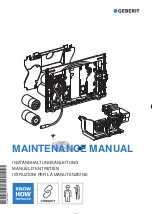
7
cleaned under fresh water and mounted again.
3. Cleaning. If the bacterial biomass has increased after some years, the
Bactoballs
can be
removed, cleaned with aquarium water and filled in again.
4. Renewal of
Deniballs
. The
Deniballs
have to be refilled/replaced once per year.
5. Feeding with
Denimar
. Without
Deniballs
: 5 tablets/day.
6. From time to time measurement of nitrite and nitrate concentrations in the outlet of the
Nitratereductor.
9. Options
With a redox potential control, the function of the
Nitratereductor
can be optimised and the
reliability can be increased.
The optimal working point of the
Nitratereductor
can be determined by a measurement of
the redox potential.
Denitrification and redox potential
The redox potential is a parameter which can be measured electronically. The value is a
measurement for the equilibrium between reducing and oxidising reactions in the water.
The redox potential in the aquarium itself is kept at plus 200 - 400 mV (Millivolt). This high
redox potential indicates, that oxidation reactions dominate over reduction reactions.
Oxidation reactions are biochemical reactions, where a substance is oxidised, e.g. by oxigen.
A negative redox potential indicates the absence of oxigen and is lethal for most aquarium
inhabitants.
The biochemical conditions in the
Nitratereductor
differ completely from those in the
aquarium: Nitrate has to be reduced to nitrogen gas. This is only possible if there is no oxigen
dissolved in the water.
The redox potential is low or even negative. The ideal range is between -50 and -250 mV.
If it exceeds -50 mV, the denitrification reaction may stop at the nitrite stage!
If it falls below -300 mV, all the nitrate is reduced. The bacteria then start to use sulphate.
This is a very undesired process because the end product of this reaction is Hydrogensulfide.
Hydrogensulfide (H
2
S) is toxic and smells very strange like fouling eggs.
If a little bit of Hydrogensulfide is entering the aquarium, this is not critical. It is immidiately
oxidized to sulphate. The closed version of the Nitratereductor causes no problems with bad
smell.
Control of the Nitratereductor
The
Nitratereductor
can be controlled by the rate of feeding or the flow rate of water:
If the redox potential exceeds -50 mV or even gets positive, the dosage of food can be
increased or the flow rate decreased.
If the redox potential sinks below -300 mV, the feeding can be reduced or the flow rate
increased.
If you work with the
Denimar
tabs, you should keep the flow rate constant and vary the food
supply. If you work with
Deniballs
, you should vary the flow rate.
10. Failures


























